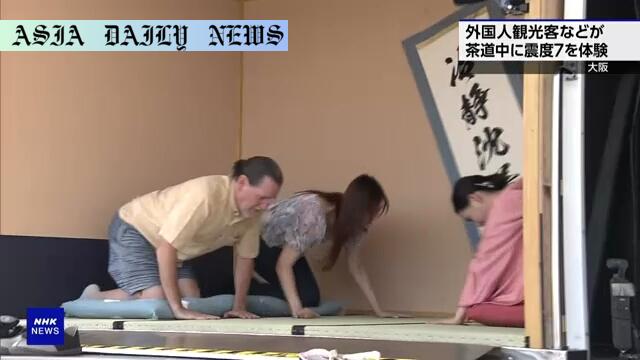Earthquake Simulation: Tourists in Japan experience a traditional tea ceremony while safely enduring simulated earthquake tremors.
Participants experienced a simulated earthquake during a traditional tea ceremony.
Omotenashi Bosai project in Osaka aimed to make tourists safer in disasters.
The simulation reached level seven on Japan’s earthquake intensity scale.
Visitors learned about earthquake preparedness during their travels.

Introduction: A Unique Quake Safety Initiative
In an innovative move to promote disaster preparedness among tourists, the Omotenashi Bosai project in Osaka, Japan, paired cultural traditions with simulated earthquake experiences. This groundbreaking event took place in a specialized earthquake simulator truck, which offered visitors a tangible lesson in quake safety while enjoying a traditional tea ceremony. The initiative is designed to make tourists more aware of how to handle natural disasters, especially in earthquake-prone regions like Japan.
The Experience: Tea and Tremors
Set up on the bed of the simulator truck, the tea ceremony room featured traditional tatami mats and a serene hanging scroll. Conducted by a skilled host dressed in a kimono, participants were first guided through the customs of enjoying sweets and green tea in the traditional Japanese manner. Moments later, however, the calm was disrupted by a simulated seismic event, replicating earthquake shocks of level seven—the highest intensity on Japan’s earthquake scale.
The simulation emphasized the importance of staying calm while providing first-hand experience of the disorientation caused by such quakes. Participants clung to floor cushions and tatami mats for balance. Through this engaging activity, tourists gained a visceral understanding of earthquake dynamics, which could save lives in a real crisis.
Tourist Feedback: Safety Meets Adventure
Tourists attending the event shared insightful reactions, acknowledging how the experience enhanced their awareness of earthquake risks. A visitor from the United States noted how the simulation, although controlled, underscored the fear and chaos that a real quake could trigger. This feedback aligns with the project’s goal: to combine cultural appreciation with a crucial public safety lesson. Such responses indicate the potential global impact of similar initiatives in disaster-prone regions.
Learning from Tradition: A Fusion of Culture and Preparedness
The Omotenashi Bosai project bridges cultural education with practical survival skills. By incorporating traditional elements like the tea ceremony, the initiative connects tourists to Japanese culture while emphasizing readiness in emergencies. The innovative fusion demonstrates how educational initiatives can be creative yet impactful. In a global era where cross-cultural experiences are highly valued, such projects offer a unique way to spark international engagement in disaster preparedness.
The Broader Impacts of Safety Awareness
Earthquakes are an unpredictable aspect of Japan’s natural environment, making preparedness a key component of the country’s safety strategies. Events like this serve as a reminder that disasters can strike at any time, anywhere. Incorporating such awareness into travel experiences helps visitors develop a mindset of vigilance and proper response mechanisms. The broader implication is clear: education through experience leaves a lasting impression, essential in emergency scenarios where instincts and forethought are critical.
Conclusion: Lessons from the Shaky Tea Ceremony
By combining cultural traditions with simulated disaster training, the Omotenashi Bosai project succeeds in delivering an unforgettable experience. The initiative not only fosters respect for Japanese customs but also emphasizes the importance of disaster readiness, equipping tourists with essential skills to stay safe. As global travel continues to surge, projects like these set an example for integrating education and safety into tourist activities worldwide.



Commentary
An Innovative Blend of Culture and Safety
When it comes to combining education and tourism, Japan always seems to be ahead of the curve. The Omotenashi Bosai project in Osaka is no exception, offering tourists a one-of-a-kind way to learn about earthquake preparedness through a simulated and cultural experience. The idea of pairing a traditional tea ceremony with a seismic simulation is nothing short of brilliant, creating an engaging but essential lesson for visitors. It showcases how safety training can be both effective and memorable. Projects like these inspire new possibilities in using local cultural experiences to address global challenges like natural disasters.
Enhancing Travel Awareness
For anyone visiting a foreign country, understanding local safety protocols is often secondary to experiencing landmarks and dining out. However, the Omotenashi Bosai project subtly shifts this mindset by embedding safety education into a quintessentially Japanese tradition. This not only enriches the tourist experience but also provides travelers with potentially life-saving knowledge. If initiatives like this became more common globally, they could revolutionize how safety practices are communicated during travel, giving people a tangible way to prepare for unforeseen emergencies.
A Global Template for Disaster Preparedness
This event also raises an important question: can other countries replicate Japan’s approach to tourist-focused disaster preparedness? Imagine earthquake simulators being set up in California, or hurricane education booths in the Caribbean. By linking cultural immersion with safety protocols, places worldwide could strengthen resilience against disasters while offering something unique to visitors. The Omotenashi Bosai project provides a perfect blueprint for how tourist experiences and public safety initiatives can go hand in hand, creating a more informed and prepared global traveler.